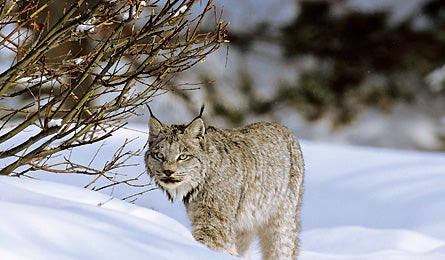The Missing Lynx

'(Photo by John Marriott)'
A ring of 13,000-foot peaks dominates the skyline surrounding Margy’s Hut, a backcountry refuge at the edge of Colorado’s Hunter-Fryingpan Wilderness. The view is attention-grabbing, to say the least. But my attention is focused for the moment on one round, fist-size impression among a flurry of animal tracks in the snow. Like a lottery ticket, the hole fills me with a sense of hopeful excitement: Maybe it’s tangible evidence of a rare animal I’ve seen only in field guides. Pulling a laminated card from my pack, I squat beside the hole in the snow and try to determine whether or not it’s a paw print left by a lynx.
Like most winter visitors to Colorado’s Tenth Mountain Division huts, I’ve come to the wilderness in search of high-alpine solitude and sweet backcountry skiing. But while I’ll score plenty of both during my stay at 11,300 feet, I’ll also track lynx, joining an initiative to turn hut visitors into citizen biologists. The goal: collect evidence of the endangered predators to help scientists gauge their prospects for survival in Colorado.
Lynx had completely disappeared from the state by 1973; increasing development shrunk their habitat, and trappers killed the cats for their pelts. Then, in 1999, the Colorado Division of Wildlife launched a reintroduction program that eventually released a total of 218 lynx into the San Juan Mountains of Southwestern Colorado. Each animal was fitted with a radio tracking collar–but over the years, many transmitters got lost or ran out of juice, and of course kittens weren’t born wearing collars. Without that electronic data, researchers have trouble judging the status of these elusive cats, making on-the-ground tracking critical to the ongoing reintroduction effort.
Winter is the best time to monitor movement, as the snow captures tracks. And from December through April, nearly 40,000 snowshoers and skiers visit the Tenth Mountain Division huts, which are scattered throughout the Rockies above 9,000 feet–prime lynx habitat. Recognizing this potential army of volunteers, the DOW partnered with the hut association in 2007 to educate visitors about lynx behavior and ask them to report tracks and sightings. Each hut now has a binder with laminated tracking tutorials and forms for recording the location of any signs.
Early returns have DOW officials feeling optimistic about the lynx’s return. Lead scientist Tanya Shenk says she received about 20 reports from hut visitors last winter (about 15 percent of all volunteer tracking reports), plus news of a rare sighting near Francie’s Cabin, a backcountry shelter outside of Breckenridge. These signs supplement the DOW’s radio collar data, suggesting that 150 to 200 cats now live in Colorado’s mountains.
But Shenk cautions that the detective work is not done. “We need to see at least five more years of data indicating that reproduction and survival is exceeding mortality before we can confirm their long-term viability,” she says. Indeed, after five years of consistent reproduction, the reintroduced lynx stopped producing kittens in 2007. That might indicate a struggling population, says Shenk, or might correspond with a recent decline in their preferred prey, the snowshoe hare.
Unfortunately, my visit doesn’t turn up any clues. Lynx tracks are hard to identify, as the cat’s thick fur blurs its prints into undefined holes in the snow. And though the holes I’ve found are surrounded by snowshoe hare tracks and a spruce-fir forest–two indicators of possible lynx presence–they lack the cat’s stride pattern. Yet the search is hardly fruitless. Everywhere I look, foxes, hares, and pine martens have stitched their prints into the snow, revealing wildlife dramas where I previously had seen nothing. I might not glimpse a lynx, but I’ll never look at its high-mountain habitat the same way again.